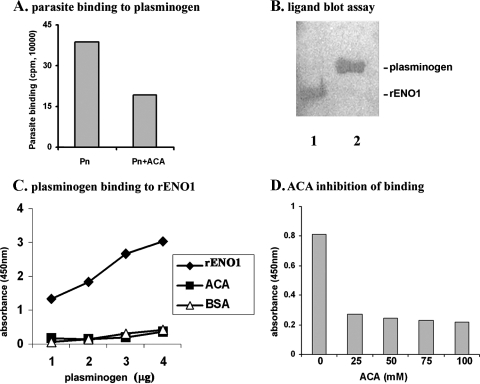FIG. 6.
Plasminogen binding assay. (A) T. vaginalis parasites bind to human plasminogen. 3H-labeled T. vaginalis cells (1 × 105) were incubated with immobilized plasminogen (Pn) for 20 min at 37°C as mentioned in Materials and Methods. (B) Plasminogen binds to tv-rENO1. The tv-rENO1 (lane 1) and human plasminogen as a control (lane 2) were electrophoresed by SDS-PAGE on a 10% acrylamide gel. After electrophoresis, proteins were blotted onto a Hybond-P membrane and incubated with plasminogen (35 μg/ml). The blot was probed with anti-plasminogen IgG antibody followed by secondary antibody. The bands indicate plasminogen bound to tv-rENO1 immobilized on the membrane (lane 1). (C) Plasminogen binds to tv-rENO1 immobilized on microtiter well plates in a concentration-dependent manner. ELISA was performed in a multiwell plate coated with tv-rENO1 (1 μg/well) and increasing amounts of human plasminogen (1 μg to 4 μg). In a competition assay, 40 mM ɛ-ACA was included during incubation with plasminogen. Control wells lacked tv-rENO1 and were coated with only BSA (1 μg well). The assay was performed at A450 using antibody to plasminogen. (D) Effects of different ɛ-ACA concentrations on plasminogen binding. Various concentrations of ɛ-ACA (25 mM to 100 mM) were added to wells containing 1 μg immobilized tv-rENO1, followed by the addition of plasminogen, and ELISA was performed as described in Materials and Methods. The results represent the averages from four independent experiments with quadruplicate samples. These experiments were very reproducible and never varied by more than 5% of the average shown here.

